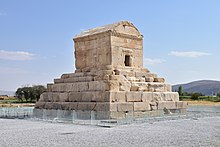
Back باسارغاد Arabic Pasarqad Azerbaijani پاسارقاد AZB Пасаргады Byelorussian Пасаргада Bulgarian পসারগাদে Bengali/Bangla Pasargad BS Pasàrgades (ciutat) Catalan Pasargadae CEB Pasargady Czech
پاسارگاد | |
 Tomb of Cyrus the Great in Pasargadae | |
| Location | Fars province, Iran |
|---|---|
| Region | Iran |
| Coordinates | 30°12′00″N 53°10′46″E / 30.20000°N 53.17944°E |
| Type | Settlement |
| History | |
| Builder | Cyrus the Great |
| Material | Stone, clay |
| Founded | 6th century BCE |
| Periods | Achaemenid Empire |
| Cultures | Persian |
| Site notes | |
| Archaeologists | Ali Sami, David Stronach, Ernst Herzfeld |
| Condition | In ruins |
| Criteria | Cultural: (i), (ii), (iii), (iv) |
| Reference | 1106 |
| Inscription | 2004 (28th Session) |
| Area | 160 ha (0.62 sq mi) |
| Buffer zone | 7,127 ha (27.52 sq mi) |
Pasargadae (/pə'sɑrgədi/;[a] Persian: پاسارگاد, romanized: Pāsārgād) was the capital of the Achaemenid Empire under Cyrus the Great (559–530 BC). Today it is an archaeological site located just north of the town of Madar-e-Soleyman and about 90 kilometres (56 mi) to the northeast of the modern city of Shiraz. It is one of Iran's UNESCO World Heritage Sites.[2] It is considered to be the location of the Tomb of Cyrus, a tomb previously attributed to Madar-e-Soleyman, the "Mother of Solomon". Currently it is a national tourist site administered by the Iranian culture of world heritage.
- ^ Gershevitch, Ilya, "Iranian Nouns and Names in Elamite Garb", Transactions of the Philological Society 68 (1), pp. 167–200, 1969 (1970)
- ^ Ancient Pasargadae threatened by construction of dam, Mehr News Agency, 28 August 2004, archived from the original on 11 March 2007, retrieved 15 September 2006.
Cite error: There are <ref group=lower-alpha> tags or {{efn}} templates on this page, but the references will not show without a {{reflist|group=lower-alpha}} template or {{notelist}} template (see the help page).
